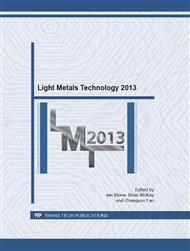p.38
p.42
p.47
p.54
p.59
p.64
p.69
p.77
p.82
Effects of Bismuth on the Microstructure and Mechanical Properties of AlSi9Cu3(Fe) Die Casting Alloys
Abstract:
In secondary die cast Al alloys, Bismuth is generally considered an impurity element and present as a trace element in commercial foundry alloys. In the present work, the influence of different Bi content on the microstructure and mechanical properties of a commercial die cast AlSi9Cu3(Fe) alloy is investigated. The Bi level ranges between 0.015 and 0.3 wt.%. The results show that the presence of Bi seems to not produce significant changes in the microstructure and mechanical properties. Fine Bi-rich compounds are observed in the die cast alloys and they are mainly distributed in the interdendritic regions and along grain boundaries. TEM investigations revealed a complex Bi-Bi2Mg3 eutectic structure, which presents mainly rod-type and blocky morphology.
Info:
Periodical:
Pages:
59-63
Citation:
Online since:
July 2013
Authors:
Price:
Сopyright:
© 2013 Trans Tech Publications Ltd. All Rights Reserved
Share:
Citation:


